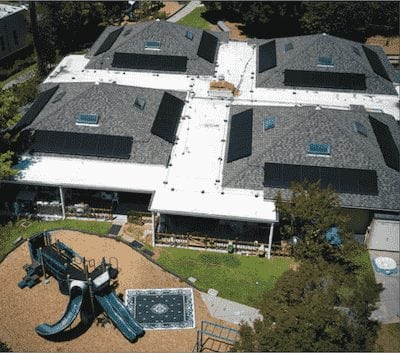
Santa Cruz Montessori School Goes Solar

Patience is a virtue. A decade of patience makes miracles happen.
In 2008, the Santa Cruz Montessori (SCM) board approved a strategic action plan for the greening of the school. Junior high students in the Wavecrest class were tasked with organizing a Green Science Fair to determine the most effective way the school could go green. The winner: solar panels.
Enter the villain, the economic downturn of 2008. With a shrinking economy, greening plans had to be put on hold.
Fast forward ten years. The tireless efforts of a capital campaign raised $265,000 through the generosity of parents, grandparents, friends, charitable organizations, and community members who contributed to Santa Cruz Montessori’s Going Solar. As a result, SCM is now 98% energy independent thanks to the 160 solar panels that have been placed on roofs of the school that are well oriented for sun exposure, and the school also has a new roof on the Primary building.
Installed by NorCal Solar in the fall of 2017 and the spring of 2018, the solar panels produce over 104,000 kWh (kilowatt hours) annually, enough to save SCM $17,000 in 2018 alone. At that rate, the solar panels will pay for themselves in about fifteen years. Just as important is the reduction of the school’s car- bon footprint—each year the savings in CO2 emissions will be the equivalent of planting nearly 2,000 trees.
“We are thrilled to have environ- mentally friendly solar panels,” noted Head of School Kim Saxton. “We are not only saving money, but are also making a positive environmental impact.”
Maria Montessori, founder of the Montessori system famously said, “The land is where our roots are. The children must be taught to feel and live in harmony with the Earth.” The greening of SCM is another step in that educational process, a model for students on how they can be responsible environmental citizens.
Next addition to the solar panels project will be an informational kiosk that will have information for students about how solar energy works. The students will also have access to a digital display of the school’s savings—projected at $85,000 over the next five years— and will be able to track the school’s reduction of CO2 emissions, targeted at 81 tons each year. The kiosk will also acknowledge the generous donors who made this project possible.
All thanks to an under-valued virtue in today’s wired, multi-tasking world: patience.


You May Also Like

On a Roll: Tips on How Kids Learn to Bicycle
August 27, 2018
September 2018 Editor’s Note
August 27, 2018

